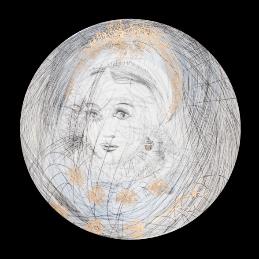Rare Dali Collection Coming to Zionsville (For Free!)

For many of us, the name Salvador Dali is synonymous with “surrealism.” While we may know him for melting clocks and a gravity-defying mustache, Christine Argillet has personal memories of a man who had two sides: an extravagant artist with a flair for the dramatic, and a quiet, hardworking man who spent his time immersed in art and literature. As the daughter of Pierre Argillet, Dali’s publicist and confidant in the 1960s and ’70s, Christine Argillet is the curator of her family’s collection of Dali’s work. On May 12 and 13, she will accompany the traveling exhibit Dali: The Argillet Collection at CV Art Gallery in Zionsville. The exhibit, on display at the gallery May 6–16, features etched copper plates and tapestries, as well as Argillet family photos and films.
“My father came into contact with Dali in the mid-1930s,” says Christine Argillet. “My father was passionate about Dali’s work, and they reconnected after the Second World War. When they reconnected, my father was a publisher for Dada and Surrealist works, but he had such pleasure working with Dali that he sort of put the other artists aside to concentrate on working with him.”
At that point, Dali did not have a publisher, giving Pierre Argillet an opportunity to work in-depth with the Spanish-born artist. “It was a great joy for them to work together,” says Christine Argillet. “It wasn’t always easy, because Dali was jumping from one thing to another very rapidly, and you had to adapt. My dad wasn’t patient in his true character, but he was with Dali.”
As a child and teenager, Christine sometimes traveled with her father to spend summers in an inn in front of Dali’s home in Madrid.
“We would stay there because otherwise, Dali would sell work that he had prepared for my father,” says Christine. “My father would be very upset, and Dali would just say ‘Oh, I’ll do another one for you.’”
The professional relationship between Dali and Pierre Argillet ended in 1974, when Dali decided to stop etching due to eye problems. Dali was willing to let the publicist reproduce prints of his works, an offer which was refused. “My dad had around 200 etchings made by Dali on traditional copper plates, and he didn’t want to have something that he viewed as being nothing more than a signed poster,” says Christine.
With the plates, tapestries, and porcelain work, she sees this collection as a unique look into the mind and talent of one of the 20th century’s most famous artists.
“There’s nothing similar,” she says. “It’s more spontaneous than the larger paintings we all know. They reveal his fantasies, and it’s touching because it’s close to his inner character.
Perhaps no one other than the man himself knew Dali’s inner character quite like the Argillet family. While his famed persona painted a picture of an extravagant extrovert, Christine remembers a very different character.
“My father’s perception was that Dali was extremely shy, and, as very shy people tend to do, he would overdo it in front of a crowd,” she says. “In order to be visible and be seen as extraordinary, he would overbid. When my father and I would see him working, he would have house slippers on and have no accent. He was just very natural.”
Despite the more subdued, private persona that she was familiar with, a trip to Dali’s home was never short of an amazing experience for the young Argillet. For instance, she recalls a living turtle, a favorite animal of Dali’s, with an ashtray attached to its shell. The reptile would walk freely around Dali’s living room, bringing the ashtray back and forth between the room’s inhabitants.
“He was always interested in something different. From film to science, he wanted to be a Leonardo da Vinci of the 20th century,” says Christine.
One of the works that will be on display in Indianapolis was made in 1963 and was inspired by Dali’s interest in Greek mythology and his proximity to water.
“His house was on the shore of the Mediterranean Sea,” says Christine. “He had the idea to grab a dead octopus that he found washed up on the shore. He immersed it in acid, and put it on a copper plate. The animal’s shape imprinted on the plate, because the acid would eat away at the copper. That was used to create Medusa.”
At that house, Dali was also known to put sea urchins in a plastic, transparent box at the bottom of his pool to detract guests from jumping in.
Christine recalls Dali as “kind and humorous, but never smiling,” and a man who loved to be challenged and have what he called the “manifestation of chance” and grab for it.
Today, 28 years after his death, the works of Salvador Dali are recognized and admired by people of all ages. “He had extraordinary freedom to express himself,” says Christine. “He had a way of making sense of the ridiculous aspects of daily life.”
At many gallery exhibitions, she finds that some people notice and question aspects of Dali’s works that she previously hadn’t. “He had an immense imagination and put together elements that were surprising,” says Christine. “There are so many layers to his art. You see some things that appear to be happy and light, and you look closer and realize that it has a deep and important message. That’s the most beautiful thing about his art.”
Dali: The Argillet Collection is on display at CV Art and Frame Gallery (110 S. Main St., Zionsville, 317-873-2976) May 6–16. Christine Argillet will be on hand 6–8 p.m. Friday, May 12, and 1–3 p.m. and 6–8 p.m. Saturday, May 13. Admission is free, but RSVPs are requested.






